
Specialized 2010
‘Tis the season for product launches. Just before the start of the Crankworx weekend in Whistler, Specialized held their first (annual?) big-travel bike launch. In previous years, they’ve done a single launch for all of their product lines. I suppose with our niche growing in size, it made sense to focus on just the big bikes. With free summer hours few and far between, I’m glad they set up the product launch the way they did, although if their other bikes were on hand I would have snuck off to the side for a moment to check out the new Shiv TT rocket. Anyway, I woke up early Thursday morning and set off for Whistler to meet up with the Specialized crew prior to the first round of presentations.
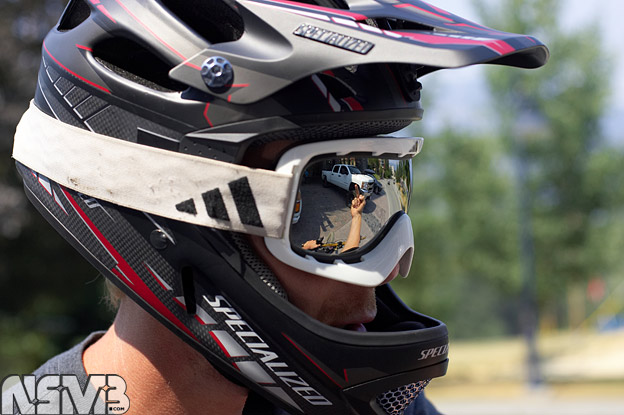
Matt Hunter wanted to show me his new lid. Pretty sweet design.
The presentations were short and sweet, leaving the better part of each day for riding. There were some familiar faces from other bike publications on hand to check out the new bikes along with some soon-to-be familiar faces, for a total of 10-12 journalists. Also in attendance were the members of the Specialized Monster Crew, including Darren Berecloth, Matt Hunter, Sam Hill, Trond Hansen and Brendan Fairclough. It was great to hear their first-hand feedback on the bikes during the technical portions of the presentations. It was also a pleasure to meet and ride with Jason Chamberlain, the man behind the engineering of the big bikes.

Decision time – take your pick of the bikes to ride for the day. Included in the price was a lot of gawking from the punters on the hill.
We started at the top – not of the mountain, the bikes. New for 2010 in the realm of the Demo 8 are some slight geometry changes. The adjustable geometry setting via the front shock mount is gone. The Demo 8 now sits at 13.5″ from the ground to the BB, with a 5mm increase in the top tube length on the small and medium size frames. This slackens the seat tube angle slightly and the head tube angle remains the same as last year. Rear travel has been reduced to 8″ from 8.4″, but maintains the same stroke length in the shock. The head tube angle is 64 degrees. These changes are the result of a lot of feedback from Sam Hill, and accordingly the Demo 8 is a full-on downhill machine. Handlebars are also lower thanks to a 1.5″ head-tube with integrated headset. Not many other companies can afford to manufacture components via cold-forging. A lot of the pieces on the high-end models of the big bikes are cold-forged alloy or magnesium. I asked Jason about the process and he described the cold-forging press being about 30 feet high and capable of applying over a million pounds of pressure. As I understood it, greater strength comes from these parts because the molecules are pushed closer together, and the grain in the material is maintained (much like bending a piece of wood along its grain is much stronger than cutting and gluing pieces into the same shape).
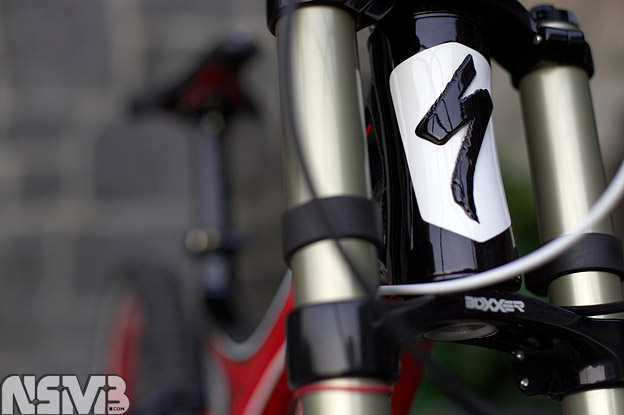
1.5″ cold-forged head tube on the 2010 Demo 8 II
My current Whistler bike is a 2005 Demo 9, size huge. I’ve been riding it each season and have grown used to its weight and the ridiculous amount of travel it serves up. I didn’t get a chance to ride the new Demo 8 until the next week at Crankworx (fast-forward to this past weekend). I’m the first to admit that I’m not an all-star rider, but generally I feel like I can hold my own most of the time. Part of my routine when riding Whistler is to get a warm-up lap in, something I take pretty seriously. After I grabbed the Demo 8 on last weekend’s cool and overcast Saturday morning, I met up with a contingent of the NSMB crew who decided it was a prime time to head directly over and up to Ride Don’t Slide. I’m not sure what the protocol is on discussion of this trail, so I won’t go into details. Let’s just say that I didn’t get my warm-up lap in, and with recent rainy conditions, it was a great challenge to live up to the moniker of the trail. Luckily I was on the Demo 8, and fortunately I had ridden the trail once before. I knew what I was getting into, and I loved every second of it.
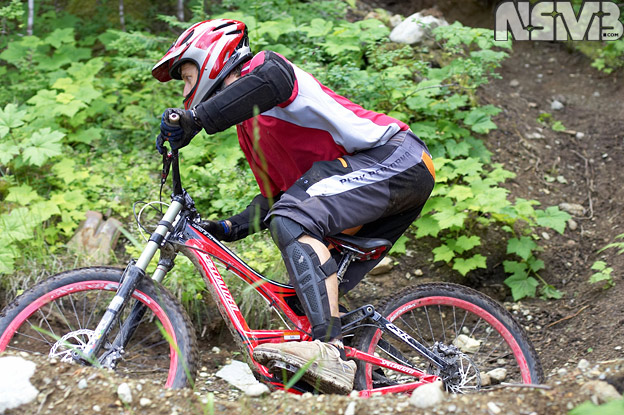
The berm at the end of Ride don’t Slide. Photo: Cam McRae.
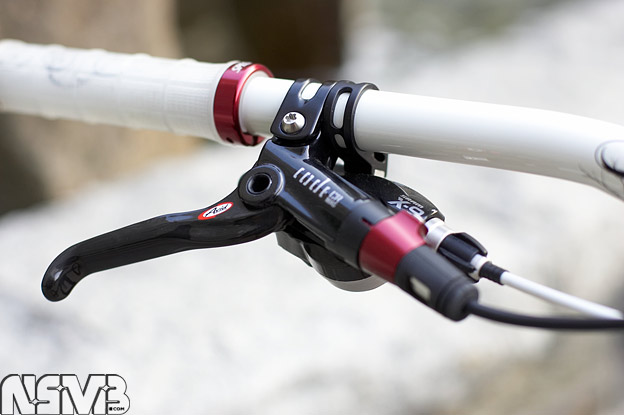
Custom Avid Code/Elixir mix brakes.
The 8 felt great, especially the back-end. With the slight changes to the geometry and slightly less travel, the rear suspension was tweaked to have a little more natural progressiveness and it ramps up more to avoid bottom-out. The chainstays are stock 16.5″. With a short rear-end, the bike feels quite agile and snappy. According to Sam Hill, initial worries about high-speed stability aren’t an issue at all. 170mm crank arms are stock, but the DH guys are running 165m. Specialized has custom Avid brakes: Codes with an Elixir lever for lighter weight. They also have custom red anodized 30mm DT rims. I saw quite a few rims that were out of true by the end of the day, as well as some nasty dents. By most accounts, the rims felt a bit “soft.” Maybe something for Specialized to look into. Or maybe it was a good day of riding the holes on A-Line on brand new wheels. FSA cranks are lighter on the 2010 bike, and bar width jumps to 750mm.
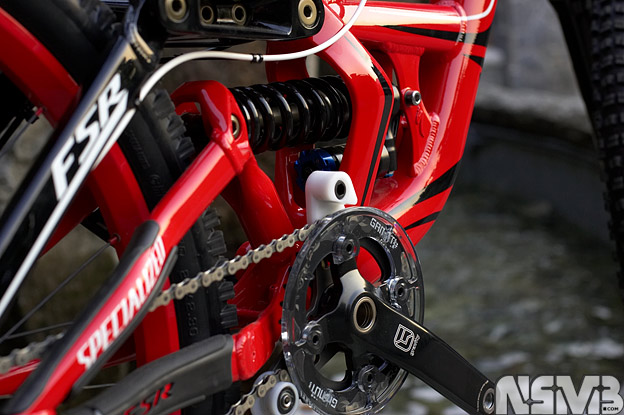
Close up of the shock assembly.
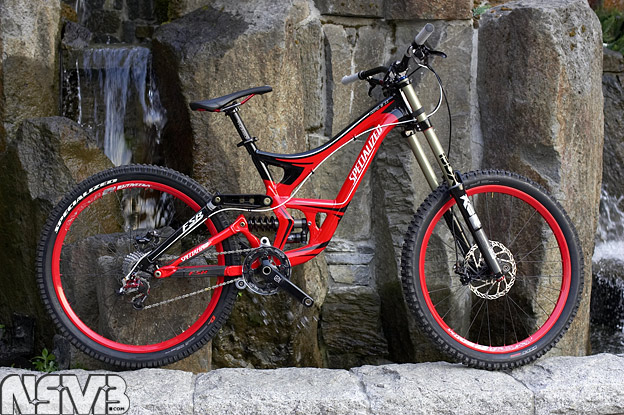
The 2010 Specialized Demo 8 II. Out of the box, a medium weighs in at 38 pounds.
On the first day of the launch after the presentation, we spent some time gathering our riding gear and setting up our bikes for the day. Available to choose were Demo 8 II’s, Demo 7 II’s, the Bighit Three and the SX Trail Two. I grabbed a large Demo 7 II and gave it a once-over to ensure it was set up the way I like it. The Demo 7 is very similar to the 8, but retains the adjustable geometry via rear-shock mounting position. Riding the 7 on familiar trails in Whistler left a huge impression on me: I want to sell my Demo 9. The 7 felt more nimble, light, agile and responsive. It seemed like I was getting relatively more pop off of the jumps and had better stability in the air. Technical gnar like Goat’s Gully was simply a matter of point and shoot. I loved the bike. My time on the 7 was too short however. After lunch, I snagged on a root or a rock and did a super slow mo roll over the front of the bars. I got up and picked the bike up to make sure it was ok. Everything seemed fine until I started rolling again and noticed the front brake lever and caliper assembly was really loose on the bar. I looked a little closer and saw that the clamp which holds the brake on the bar had broken at the hinge on the under side. The way it broke meant replacing the entire caliper assembly. Boo urns. I zap-strapped it on as best I could and rode down to the village to see if I could swap bikes.
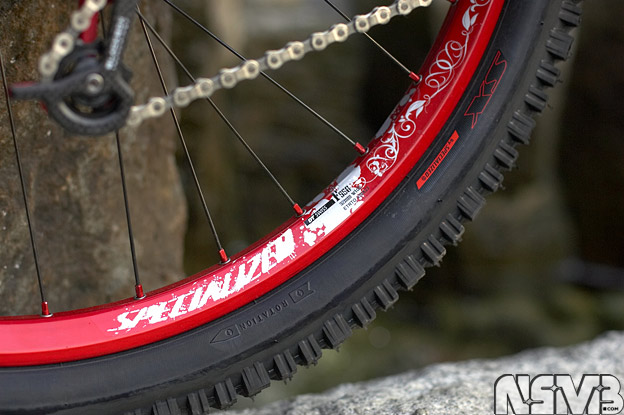
Nice looking rims, but maybe not quite strong enough for the intended use?
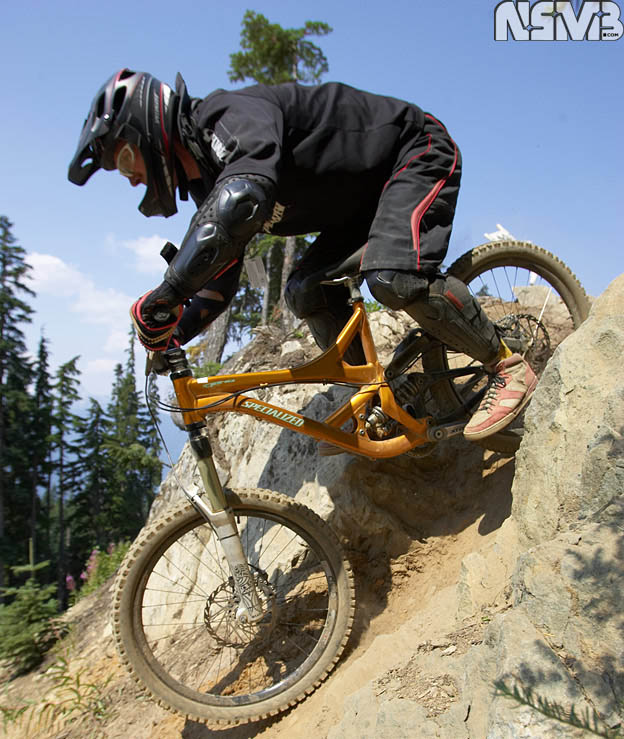
Jason Chamberlain dropping in on his Demo 7 I
Swap bikes indeed. I handed the Demo 7 over to Nicolas Sims from Specialized, and he gave me his medium sized Bighit 3. The last Bighit that I rode was the old white monocoque frame with the 24″ rear wheel. Evolution has been at work. The 2010 Bighit comes with the redesigned 2009 frame and shares the same cold-forging process for parts of the frame that its big brothers do. Specialized look at the Bighit as an entry level downhill bike. The component spec is durable, but not pricey. Chain guides are custom units from Gamut. This was my first experience with the guides, and on both the Demo 7 and Bighit, I was having issues pedaling backwards. The chain would often ride on top of the chainring, hugging right up against the bash guard. I heard other riders expressing similar concerns. On the Demo 8 however, the guide worked perfectly. Back to the Bighit: not much is new aside from lighter cranks, new racer-inspired paint, and a 750mm bar. It is also running a Specialized Clutch front tire. The Demo 7 had a Clutch front as well, and a Specialized Chunder on the back. I was really impressed with these tires. The compound felt quite soft, and sure enough, they stuck to everything I rode. The Bighit I had borrowed wasn’t set up for my riding weight (I could have used a stiffer spring on the shock) and the back tire had signficiantly lower pressure than what I typically ride. I kept waiting to pinch flat, but it never happened.
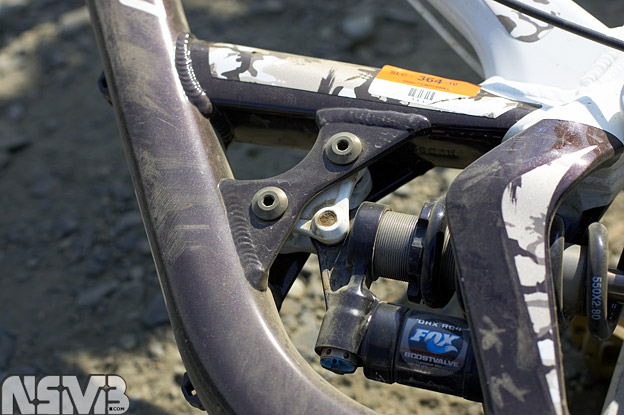
Geometry adjust on the Demo 7 II: flip that little triangle at the shock mount to raise the bb 12mm and change the head angle by a degree.
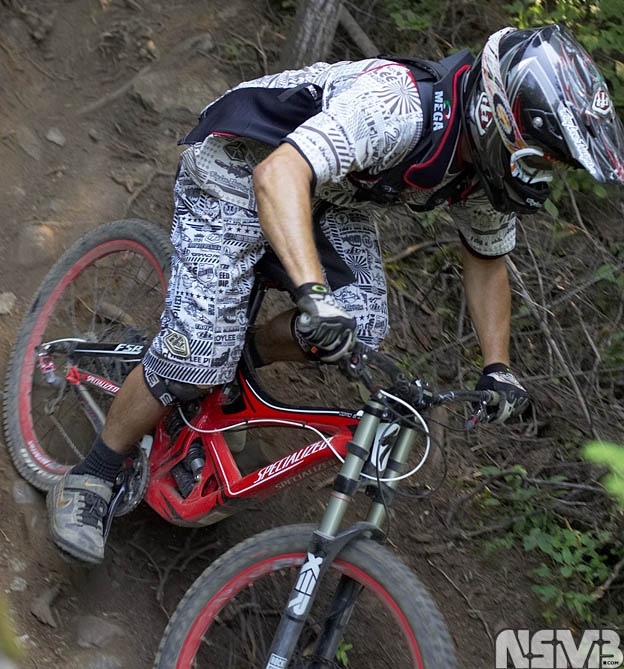
Jonathon Taylor from Revolution MTB (Australia) loving his Demo 8.
I can’t forget about the 2010 SX. Unfortunately I didn’t get a chance to ride one. Aside from some slight changes in the frame design around the shock, there isn’t much different on the 2010 model from 2009 (all the standard stuff: Clutch front tire, lighter FSA cranks, 750mm bar and those custom Avid Elixir/Code brakes). There are 2 versions: 6.6″ rear on the regular version, and 4″ on the slalom version. The RC4 shock has a bigger reservoir which required the top tube to become a little bit straighter to accommodate the upright position of the shock. The left and right links that attach the shock to the swing arm are coupled at the axle where the shock actually mounts. This ensures the two links can never move independently from one another (resulting in increased stiffness). The slight changes to the frame result in a net weight reduction of 100g, bringing the weight in around 36-37 pounds depending on the model. The slalom version still has a little more curve in the frame to accommodate Berrecloth when he does his turn-downs.
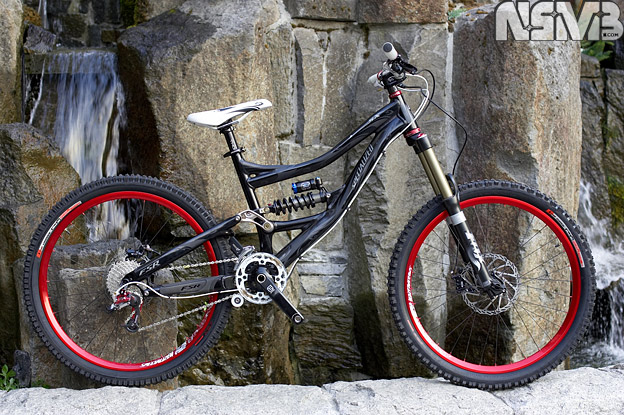
2010 Specialized SX. Darren Berrecloth says: “best all around bike you can get”. Who needs any more endorsement than that?
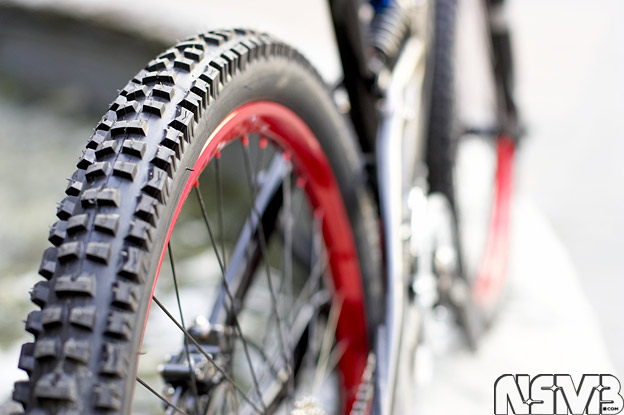
Specialized Chunder rear tire on the 2010 SX.
As per usual, I didn’t bring any riding gear suitable for XC. So on day 2, I put on my old and worn out skateshoes, my heavy DH shorts and borrowed an xc lid in anticipation of riding the new S-Works Enduro. It turns out that the bike is fully capable of living up to the type of riding it might endure by someone wearing a similar outfit to mine. It also seemed to blend right in with the guys who were wearing their xc gear. The Enduro has some major changes for 2010, the 5th generation of the bike. The 2009 model was engineered down to 30 pounds. This year the bike is less than 28 pounds out of the box. The frame is radically different in 2010. The “X-Wing” layout increases standover height and seatpost adjustments, and has a good roomy feel along the top tube. The shock yoke attached to the rear of the shock wraps around the straight seat tube. The X-wing is a monocoque piece, including the downtube. Due to advances in fabrication technology, larger pieces like this can be made without worry of rough inside surfaces on the carbon. Using a single monocoque piece the frame is 30% stiffer than last year, yet retains the same weight. Additional stiffness comes from beefed up seatstays and chainstays and hollow dropouts. There are ISCG tabs on the carbon frame – a first for Specialized – which would allow you to run Hammerschmidt or a single ring and guide. The head angle is at a very slack 66.5 degrees, and like the other bikes, the chain stays are 16.5 inches.
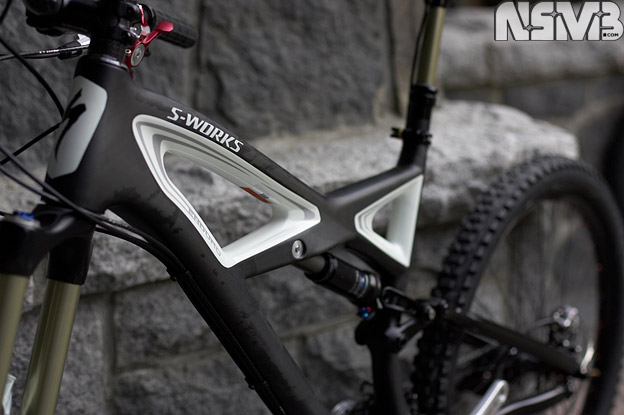
The 2010 Enduro. Sexy? or Ugly? That’s up to you. Strong? Light? Yes.
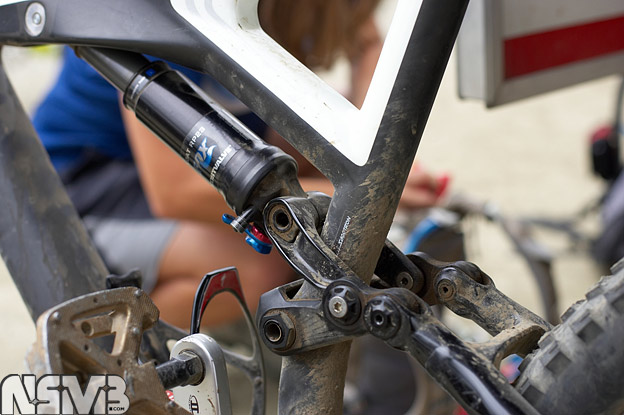
Close up of the shock mount assembly.
There was definitely a time when I was leery about riding a full carbon mountain bike on anything other than the Sea Wall in Vancouver. The trails we rode on the second day were certainly more demanding and steep than the Sea Wall, and I quickly forgot that I was riding a carbon frame. All I could think about on the way up was how much nicer it would be to have some clipless pedals. I have to admit that I’ve never ridden the XC trails in Whistler before. I was blown away. Technical ability for both climbing and descending along with a good pair of lungs are essential if you want to clean all that the XC community has to offer. Pedaling the Enduro uphill was aided by the 3-position remote activated Specialized-designed telescoping seat post; the Command Post. When the uphill turned into downhill, a slight push on the lever and some downward pressure locked the seat into one of the 2 lower positions and out of the way of my big shorts. The design, in my opinion, is much better than the Crank Bros. solution.
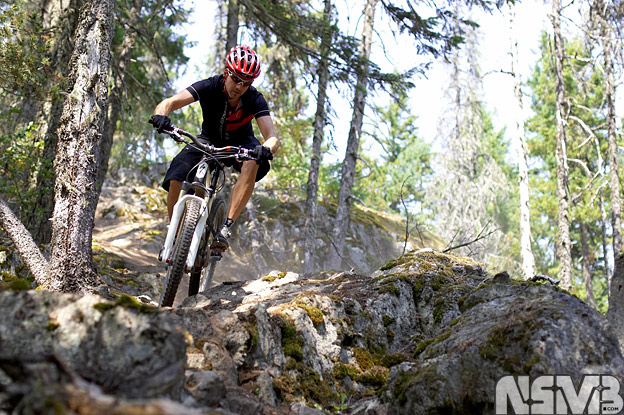
The Enduro can be ridden hard down chunky bumpy gnarly stuff and it never flinches.
On the high-end models of the Enduro, Specialized uses their own E160TA fork that works in tandem with a custom Fox RP23BV rear shock. Travel is adjustable from 160mm-135mm. The fork features a 1 and 1/8 to 1.5″ carbon steerer/crown assembly. The integrated lower bearing in the assembly directs heavy forces into the downtube, away from the fork. The fork weighs in at 4.1 pounds, and is slightly less stiff than the old E150, but has a much better strength-to-weight ratio. The lower end models have an alloy frame with the same X-wing design thanks to some hydroformed tubing. The cheapest Enduro starts at $2000 USD.
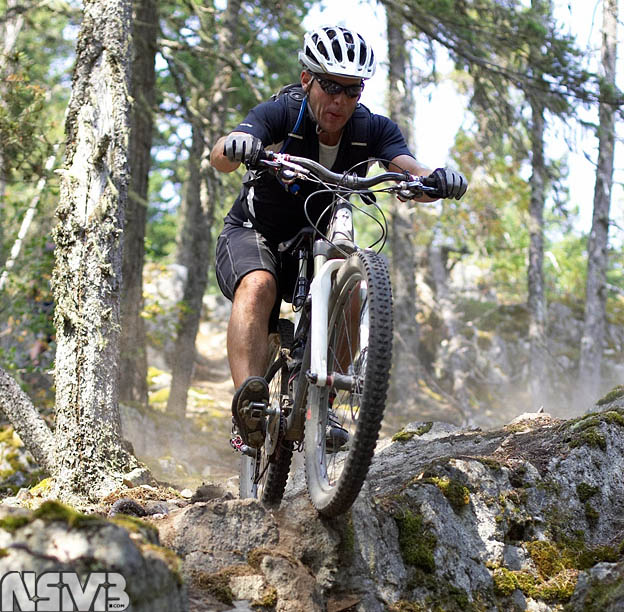
David L’Heureux from Bicycling riding lines he didn’t know he could.
As I mentioned earlier there were times when I forgot I was riding a carbon frame. The bike was taking a good beating on some of the steeper downhill sections, and it held its own. It tracked well, the suspension felt active and great and the bike had a good solid feeling overall. I don’t know if I would be in the market for an Enduro (only because I don’t have infinite money or space in my condo for another bike), but those looking for an all-mountain do everything 6″ bike should definitely take a peak at the new Enduro.
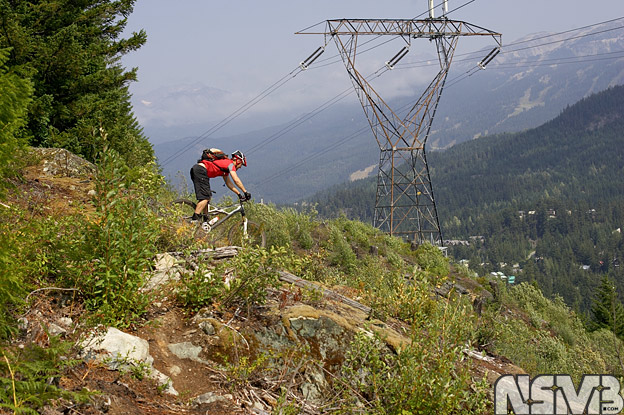
It’s not an XC ride without an XC vista photo.
I’ll quickly mention a couple other bikes. The Pitch fits in the family just underneath the Enduro. It’s an all-mountain rig featuring an “M4” alloy frame using some of the same construction techniques found the in P series of bikes. It comes fitted with a custom 140mm RockShox Pike fork and FOX or X-Fusion rear shock. The P Series dirt jumping bikes feature new paint and graphics, lighter chro-mo frames or updated aluminum frames. A switch to Marzocchi forks from Rockshox means a slight reduction in weight. The chro-mo bikes have a higher bb than the alloy bikes.
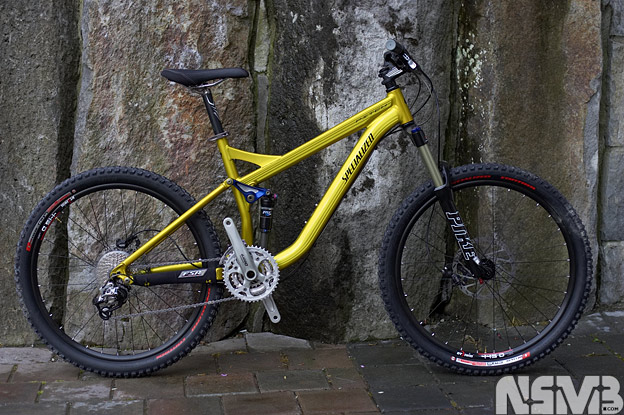
2010 Specialized Pitch in gold. A highly underrated bike that is very capable, according to the Specialized guys.
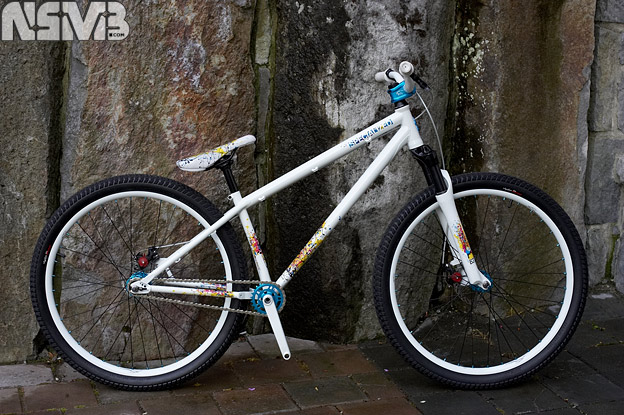
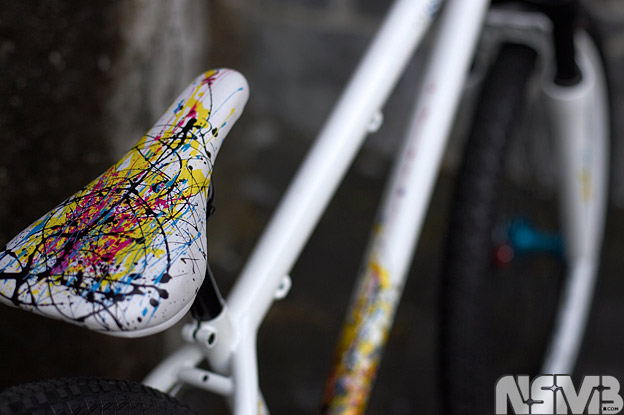
The updated and stylish chro-mo P1
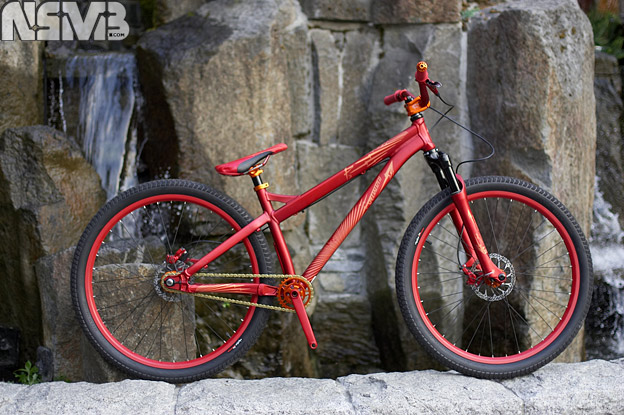
The new all-red all-the-time P3. Love it? Or hate it?
I’ve been really lucky to have a chance to demo so many bikes over the summer. I mentioned in an earlier article how hard it would be to make a decision on a new bike if I were in the market. I still stand by this observation. Although If I had to make a choice right now, I think I’d be leaning towards a Demo 7. Thanks to the Specialized crew for hosting a great couple of days and letting me have my way with a Demo 8 during the Crankworx weekend. I was sort of hoping they’d forget that I had borrowed it….
Post your comments or questions in our forum. You know the drill.
Fergs







Comments
Please log in to leave a comment.